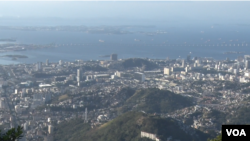Many Olympic visitors to Rio de Janeiro – including athletes, officials and their families - are in the stunningly beautiful coastal city for the first time in their lives.
If there's spare time for sightseeing, a trip to see the iconic Christ the Redeemer statue that overlooks the former Brazilian capital is high on the list of many. The Art Deco statue, made of reinforced concrete and soapstone, has overlooked Rio now for 85 years.
"We have 3,000 to 4,000 visitors a day during peak season. In low season, there are about 2,000," Jacqueline de Melo, daughter of the owners of the management company that oversees the site, told VOA. She said the crowds are especially large on Saturdays and Sundays.
Priceless experience
Christ the Redeemer is located about 20 minutes from Rio's famous Copacabana beach. A popular way to reach the top is by tram, which costs about $21. But the experience is priceless once there, said De Melo.
"You can see the city at 360 degrees from the top. And since 2007 it was included as one of the seven [new] wonders of the world,” she explained. “So everyone wants to come and see it.”
The tram going to the top is far older than the monument. The first one went into service in 1884. It negotiates 700 vertical meters to the peak of Corcovado Mountain, where the gigantic statue is perched.
The tram ride is somewhat of an adventure itself. Upon arrival, you have to climb several flights of stairs before the imposing architectural work finally appears.
‘Beautiful’
"It's very beautiful. It is one of the wonders of the world. It is very nice," Colombian visitor Luis Enrique told VOA.
"It's so beautiful. There are many things to see, and the view is amazing," said Laura Machuca from the United States.
Christ the Redeemer is 30 meters high, not including its eight-meter pedestal. Its arms stretch 28 meters across. At the top, you can see virtually all of Rio de Janeiro, like the famed Maracana Stadium, Ipanema beach, downtown and even distant suburbs.
But it's the majesty of the sculpture, created by Brazilian engineer Heitor da Silva Costa and Polish-French sculptor Paul Landowski, that enthralls visitors.
"The truth, it is a beauty. It's impressive,” said Juan Diego Calcaterra of Argentina. “We were very anxious to see it, and we are very grateful to be here."
And of course, no one leaves the iconic place without taking photos and videos – proof that they were there.











